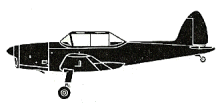
ASN Wikibase Occurrence # 181926
This information is added by users of ASN. Neither ASN nor the Flight Safety Foundation are responsible for the completeness or correctness of this information.
If you feel this information is incomplete or incorrect, you can submit corrected information.
| Date: | Sunday 28 September 1986 |
| Time: | 15:30 |
| Type: |  de Havilland Canada DHC-1 Chipmunk 22 |
| Owner/operator: | Private |
| Registration: | G-MUNK |
| MSN: | C1/0283 |
| Fatalities: | Fatalities: 0 / Occupants: 1 |
| Aircraft damage: | Destroyed |
| Category: | Accident |
| Location: | ca 2 mi S of Harwich Harbour, Essex -
 United Kingdom United Kingdom
|
| Phase: | Manoeuvring (airshow, firefighting, ag.ops.) |
| Nature: | Private |
| Departure airport: | Southend Airport, Essex (SEN/EGMC) |
| Ipswich Airport, Suffolk (IPW/EGSE) | |
| Investigating agency: | AAIB |
| Confidence Rating: |
Crashed into the North Sea, approximately 2 nautical miles south of Harwich Harbour, Harwich, Essex. The pilot survived with only minor injuries. According to the following extract from the oficial AAIB report into the accident:
"Whilst practising aerobatics on a flight between Southend and Ipswich airports, the aircraft suffered a loss of engine power. It had been airborne for 30 minutes, and had just completed a slow roll when the loss of power occurred over the North Sea.
The pilot turned the aircraft back towards land, and having failed to determine the reason for the loss of power, sent out a MAYDAY call to RAF Wattisham. Losing height rapidly, he had to ditch the aircraft into the sea approximately two nautical miles south of Harwich Harbour, Harwich, Essex, whereupon it nosed forward on impact with the water, and overturned onto its back.
The pilot released his harness, opened the canopy, and escaped from the aircraft, spending only about three minutes in the water before being rescued by a passing sailing boat. A subsequent check up of the pilot in hospital revealed that he had sustained only slight scratches and bruising
No reason for the loss of power was ever found, as the aircraft sank shortly after impact with the water, and was not recovered. However, the pilot reports that the engine appeared to momentarily recover power as the aircraft first touched the water, although by this stage it was too late to effect a recovery."
Damage sustained to airframe: As confirmed by the AAIB report "aircraft sank and was not recovered". As a result, the registration G-MUNK was cancelled by the CAA nine months later, on 29/6/1987 as "destroyed"
Accident investigation:
 |
|
Sources:
1. Royal Air Force Aircraft WA100-WZ999 (James J. Halley, Air Britain 1983, p.24)
2. AAIB: https://assets.digital.cabinet-office.gov.uk/media/5422fa88ed915d13740007a7/DHC-1_Chipmunk_22_G-MUNK_11-86.pdf
3. CAA: https://assets.digital.cabinet-office.gov.uk/media/5422fa88ed915d13740007a7/DHC-1_Chipmunk_22_G-MUNK_11-86.pdf
4. http://www.dhcchipmunk.com/census.html
5. http://www.ukserials.com/results.php?serial=WD
Revision history:
| Date/time | Contributor | Updates |
|---|---|---|
| 02-Dec-2015 20:41 | Dr.John Smith | Added |
| 02-Dec-2015 20:43 | Dr.John Smith | Updated [Source] |
| 02-Dec-2015 20:45 | Dr.John Smith | Updated [Departure airport, Destination airport] |
| 02-Dec-2015 20:45 | Dr.John Smith | Updated [Operator] |
| 02-Dec-2015 20:47 | Dr.John Smith | Updated [Narrative] |
| 21-Mar-2018 19:36 | TB | Updated [Time, Operator, Location, Narrative] |
Corrections or additions? ... Edit this accident description
The Aviation Safety Network is an exclusive service provided by:


 ©2024 Flight Safety Foundation
©2024 Flight Safety Foundation